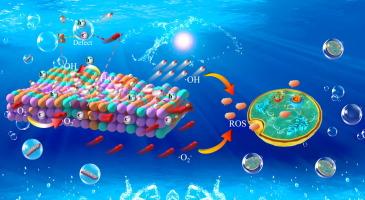单层Bi2MoO6层状异质结结构和表面“Bi-O”空位缺陷的协同效应增强了光催化抗菌性能
IF 8.1
1区 工程技术
Q1 ENGINEERING, CHEMICAL
引用次数: 0
摘要
开发高效的催化抗菌材料是缓解空气微生物污染的关键。本研究以十六烷基三甲基溴化铵为原料,通过简单的剥离法合成了具有独特的[BiO]+ - [MoO4]2−- [BiO]+层间亚结构和“Bi-O”空位缺陷的单层Bi2MoO6。这些单层化学键合形成层状异质结。在太阳照射下,[BiO]+层中产生空穴,而[MoO4]2−层中产生电子,从而实现了高效的电子-空穴直接分离。此外,[BiO]+层中大量的“Bi-O”空位缺陷导致了Bi2MoO6的晶体结构畸变、电子重分布和带隙能的变化。层状异质结构和空位缺陷的结合显著提高了太阳能的利用率,促进了光生载流子的分离,从而获得了优异的光催化抗菌性能。抑菌试验表明,辐照20 min后,单层Bi2MoO6(0.20 mg/mL)对大肠杆菌和金黄色葡萄球菌的灭活率分别为96.7 %和74.5 %。值得注意的是,单层Bi2MoO6对大肠杆菌和金黄色葡萄球菌的抗菌效率分别是多层Bi2MoO6的1.9倍和2.7倍。该研究为设计具有增强光催化抗菌效率和定制表面缺陷的层状异质结Bi2MoO6提供了新的见解和策略。本文章由计算机程序翻译,如有差异,请以英文原文为准。

Synergistic effects of monolayer Bi2MoO6 layered heterojunctions configuration and surface “Bi–O” vacancy defects of in enhanced photocatalytic antimicrobial performance
Developing efficient catalytic antimicrobial materials is crucial for mitigating air microbial pollution. In this study, a monolayer Bi2MoO6 with a unique [BiO]+–[MoO4]2−–[BiO]+ interlayer substructure and “Bi–O” vacancy defects was synthesized through a simple exfoliation method using cetyltrimethylammonium bromide. These monolayers are chemically bonded to form a layered heterojunction. Under solar irradiation, holes are generated in the [BiO]+ layer, while electrons are produced in the [MoO4]2− layer, thereby facilitating efficient direct electron–hole separation. Additionally, the abundant “Bi–O” vacancy defects in the [BiO]+ layer result in crystal structure distortion, electron redistribution, and changes in the band gap energy of Bi2MoO6. The combination of layered heterostructures and vacancy defects significantly enhances solar light utilization and promotes photogenerated carrier separation, leading to excellent photocatalytic antimicrobial performance. Antibacterial tests reveal that after 20 min of irradiation, the monolayer Bi2MoO6 (0.20 mg/mL) deactivates 96.7 % of Escherichia coli and 74.5 % of Staphylococcus aureus. Notably, the antibacterial efficiency of the monolayer Bi2MoO6 is 1.9 and 2.7 times that of its multilayer counterpart for Escherichia coli and Staphylococcus aureus, respectively. This study provides novel insights and strategies for designing layered heterojunction Bi2MoO6 with enhanced photocatalytic antibacterial efficiency and tailored surface defects.
求助全文
通过发布文献求助,成功后即可免费获取论文全文。
去求助
来源期刊

Separation and Purification Technology
工程技术-工程:化工
CiteScore
14.00
自引率
12.80%
发文量
2347
审稿时长
43 days
期刊介绍:
Separation and Purification Technology is a premier journal committed to sharing innovative methods for separation and purification in chemical and environmental engineering, encompassing both homogeneous solutions and heterogeneous mixtures. Our scope includes the separation and/or purification of liquids, vapors, and gases, as well as carbon capture and separation techniques. However, it's important to note that methods solely intended for analytical purposes are not within the scope of the journal. Additionally, disciplines such as soil science, polymer science, and metallurgy fall outside the purview of Separation and Purification Technology. Join us in advancing the field of separation and purification methods for sustainable solutions in chemical and environmental engineering.
 求助内容:
求助内容: 应助结果提醒方式:
应助结果提醒方式:


